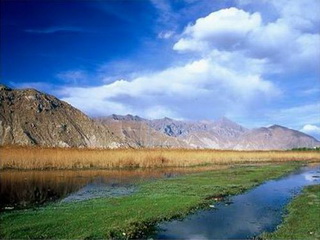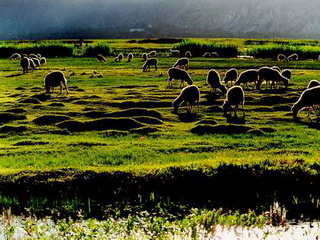search for a Trip
China has 38.43 million hectares of wetlands, ranking first in Asia and fourth in the world. The Lalu Wetland Reserve, also known as the "Lung of Lhasa", is the only wetland inside a city in China. Encased inside the prosperous city of Lhasa, Lalu is a valuable wetland treasure.
The Lalu wetland reserve is located just north of Lhasa, the capital of the Tibet Autonomous Region. It is the largest and highest natural wetland in the world, covering 12.2 square kilometers, and is an important part of a unique landscape that also includes the sacred Potala Palace. Together the two exhibit an awe-inspiring combination of culture and nature.


According to the reserve staff, over 100 million yuan has been invested to protect the wetland since 1999. And other 100 million yuan will be put into use soon. Thanks to effective protection, the Lalu Wetland Reserve has stopped shrinking. Instead it has expanded from under 6 sq km at the end of the millennium to 6.2 sq km today. Vegetation coverage, consisting mostly of grassy marsh, remains over 95 percent.
Since the establishment of the reserve, there has been a significant increase in both the variety and population of species. Currently 43 wild animal species cohabit on the wetland. The black-necked crane and the vulture, 30 aquatic and 101 insect species all live inside the Lalu Wetland Reserve.
The reserve also absorbs nearly 5,475 tons of dust and filters 10 million tons of municipal sewage from Lhasa City each year. It has become the most important oxygen source and largest air cleaner for Lhasa residents.
Since joining the Ramsar Convention on Wetlands in 1992, the Chinese government has established 535 natural wetland reserves, including low beaches by seas, lakes and rivers and forest-edge wetlands. A National Plan for Wetland Protection Actions launched in 2000 aims at stopping human activity-related shrinking of natural wetlands by 2010. Their goal is to restore deteriorated or vanished wetlands by 2020.
Related Tours:
China Attractions Guide
- Anhui Attractions
- Beijing Attractions
- Chongqing Attractions
- Fujian Attractions
- Gansu Attractions
- Guangdong Attractions
- Guangxi Attractions
- Guizhou Attractions
- Hainan Attractions
- Henan Attractions
- Hongkong Attractions
- Hubei Attractions
- Hunan Attractions
- Inner Mongolia Attractions
- Jiangsu Attractions
- Jiangxi Attractions
- Manchuria Attractions
- Ningxia Attractions
- Qinghai Attractions
- Shaanxi Attractions


